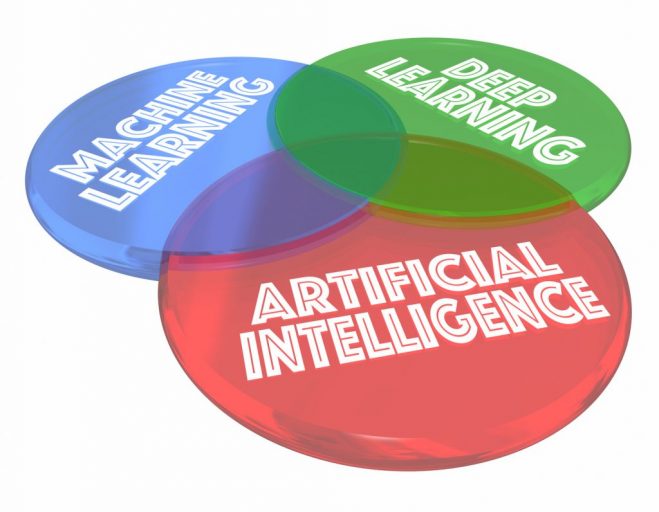Artificial Intelligence Gains Momentum: From Machine Learning to Deep Learning
February 28, 2018 | By: Ivy Schmerken

By Ivy Schmerken, Editorial Director
Artificial intelligence has quickly evolved from science fiction to digital assistants such as Alexa and Siri learning about our daily lives. A.I. applications are interpreting MRIs and will soon be operating self-driving cars. In personal finance, many of us interact with chat boxes on bank web sites. And in the investing world, robo-advisors are managing portfolios for retail investors.
“But we haven’t seen the penetration of AI within institutional finance,” said Richard Johnson, vice president of market structure and technology at Greenwich Associates on a recent webinar about the evolution of A.I. and current levels of adoption on Wall Street.

In an audience poll taken during the Greenwich webinar, “Artificial Intelligence: The Coming Disruption on Wall Street, “37.5% of attendees said that artificial intelligence would have the biggest impact on research, 34.7% trading, 23.6% compliance and 4.2% cited sales.
Among the key benefits of artificial intelligence is that it can analyze large volumes of structured and unstructured data more quickly than humans do, which can boost their productivity.
Large banks, hedge funds and traditional asset managers have been hiring data scientists to develop machine-learning algorithms that scan billions of data points, news articles, blogs, social media posts, and images.
“Machine learning cannot only find alternative data but also measure the value of satellite images, predict how much oil is in the ground or how many cars are in a parking lot,” noted Johnson.
One of the world’s biggest hedge funds, Man Group, has used machine-learning techniques to find new strategies, “from start to finish,” noted Johnson. Man runs $43 billion of its $96 billion in total assets quantitatively, mainly through algorithms, operating 21.5 hours a day, from the open in Asia to the close in the U.S., reports CNBC.
But Man Group’s AHL quantitative investment unit is now allowing the models to learn from the data and trade completely on their own, reported CNBC. The firm’s Sandy Rattray, Man’s London-based chief investment officer, told CNBC that the strategy is earning higher returns than traditional quant methods.
Deep learning refers to machine-learning algorithms with many different layers of logic. These are artificial neural–networks which replicate how the brain works, explained Johnson.
Many people are worried that artificial intelligence will automate tasks performed by humans, resulting in downsizing and job losses in banks and brokerage houses. But experts say that adoption of AI is inevitable. “AI is blending the attributes of humans with computers,” said Johnson.
While humans learn from trial and error, computers follow instructions that are programmed for them. “What’s changed is computers can learn from data, and data is a key part of the growth of AI,” said Johnson.
In research conducted last summer, Greenwich found that 18% of financial services firms had already implemented AI technology in their business, while 57% were exploring the technology and had plans to implement in the next 12 months. Overall, three-quarters of banks and financial services firms have plans to implement AI in the next 12 months, said Johnson.
One has no look no further than the compliance space, which needs to analyze large amounts of data to look for suspicious patterns.
“Spoofing is a big topic for regulators but there is really not a good definition of spoofing,” said Johnson.
The Commodity Futures Trading Commission (CFTC) has defined spoofing as the intent to mislead, but that is ambiguous.
One firm is using machine learning to analyze patterns in public spoofing cases, and then looks for those patterns in real time across 50 million public cases, said Johnson. The machine is programmed to scan the market and to alert the firm when it spots this kind of regulatory action.
A Perfect Storm for Artificial Intelligence
Although the term artificial intelligence was coined 50 years ago, it has met with limited success. However, over the past five years there’s been an explosive growth in data due to three factors. First, the Internet has given rise to billions of documents, blogs, and social media feeds like Twitter and images. Computers are able to scan data sources and identify patterns in data and calculate sentiment. Hardware advances in graphical processing units (GPUs) from Nvidia for PCs and streaming video gaming are available for number crunching as required by AI. Another driver is the growth of cloud computing from Amazon Web Services, Google and Microsoft, allowing small teams to access machine learning on demand.
Research Efficiencies
From a productivity standpoint, sell-side research is one area that is ripe for disruption, since analysts must generate many reports.
With about 4,000 publicly traded equities in the US stock market, most banks cover no more than 1,000 stocks mainly for productivity reasons, said Johnson.
Because there is a ton of structured data in finance from balance sheets, income statements, credit ratings, economic data and government data, computers can be trained to write simple quarterly results based on financial statements.
A junior analyst could write eight summary reports each day. But it would take 2,000-person days to write a quarterly research summary for each publicly traded company, estimates Johnson. That would equate to eight full-time employees dedicated to writing these quarterly research reports, he said.
“AI can generate 3,000 publicly traded reports in less than 10 minutes, whereas it would take 2,000-person days for human to do that, estimated Johnson. “So, for structured data, firms need AI for productivity reasons,” said Johnson.
Sales & Customer Service
While it’s common today to call up a bank and utilize online chat support for help with a transaction or problem, this is usually found in retail banking or wealth management. Chat could be deployed in the institutional finance support area to save time for the sales-trader. There are a number of simple questions that could be answered through chat, such as “what’s the price of Verizon five-year bonds; what is the average price of my order in stock XYZ; and did I receive any fills in this stock form dark pool A?” Today, the sales trader has to respond to an inquiry and call back with a response. “There’s no reason that we can’t train AI to do that type of stuff, which would free up the sales trader to focus on higher-valued activities,” said Johnson.
Artificial Intelligence and Trading
While banks have increased the efficiency of algorithmic trading, sell-side firms are working on ways to incorporate AI. According to estimates, 80% percent of the buy–side order flow is executed through electronic channels, and even if it goes to a sales trader, it often ends up in an algo. Market making is also electronic. “The next generation of algo trading is going to incorporate AI,” predicted Johnson. “They’re going to be better able to make their own decisions based on learning from data they have in the [internal] trading logs of millions of historical orders and figuring out the best way to execute new orders entered into the system,” said Johnson.
For example, JP Morgan & Chase Co. recently announced it has incorporated AI into their liquidity seeking algos and that they performed better than previous non-AI algorithms, said Johnson.
According to Business Insider in “JP Morgan takes AI use to the next level”, JPM has been testing its AI program, LOXM, since Q1 2017 in Europe, and planned to roll it out across its Asian and US operations in Q4 2017 after trials proved successful.
“LOXM was trained on billions of historic transactions to enable it to execute equities trades at maximum speed and at optimal prices, and to offload large equity stakes without causing market swings,” wrote Business Insider.
As machine learning and other AI technologies emerge on Wall Street, there is debate around AI’s impact on jobs. In one camp, there are fears of robots taking over the world, said Johnson. On the other side, people see AI as augmenting technology that is no different than others, said Johnson. He estimates that about 15% of jobs are at risk in financial services.
Banks have reduced headcount over the past decade, and that was before A.I., so that process is likely to continue, he said. It remains to be seen whether A.I. poses a threat to jobs, but it’s also possible that people will move into different roles.
However, AI has its limitations, such as in research where it is not good at forming longer-term investment theses. If a company hires new management and changes its strategy, a traditional portfolio manager may pick up on this growth opportunity, but an AI algorithm can’t do that, said Johnson. “There is still plenty of value out here for human PMs and analysts,” said Johnson

Recent blog posts related to Artifical Intelligence issues:
https://flextrade.com/alt-data-on-the-march/
https://flextrade.com/augmented-reality-becomes-a-reality/